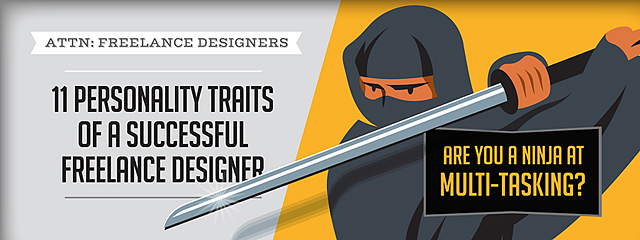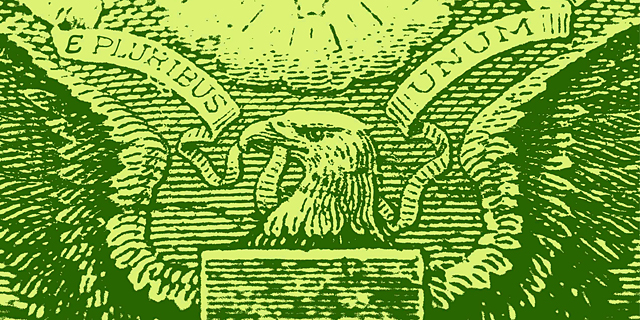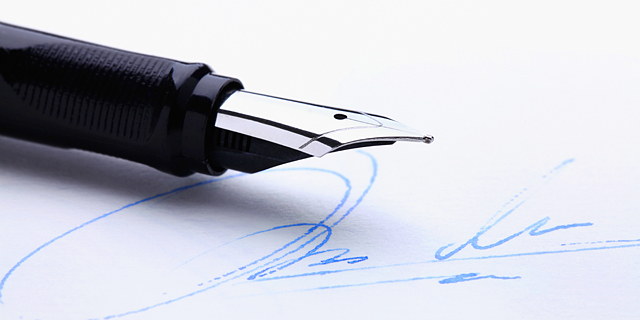
This article was contributed by Vincent Burkhead, aka Your Creative Junkie.
What type of person does it take to thrive as a successful Freelance Graphic Designer?

It’s an interesting personality mix: fiercely independent, yet collaborative, extremely confident, yet vulnerable and open-minded, firm, but flexible.
After over 20 years in the design industry and 15 years running my own design studio as a solo freelancer, I’ve learned firsthand which personality traits and practices are essential to becoming a successful freelancer, and not merely survive in this business but to thrive in it.
In this article I focus on which personality traits are required to achieve Freelance Design Success. Everyone who is creative and motivated to land their own clients (rookies or veterans alike) should find value from this content.
1. Are You a Ninja at Multi-Tasking?
Do you have the coveted multi-tasking gene? Can you envision yourself juggling 10 different projects for 8 different clients at various stages of completion?
Be prepared for the every present voices in your head:
Don’t forget to resend those T&M invoices or you won’t get paid…
Also make sure that important email from Jenifer didn’t get pushed to your spam filter…
Don’t forget to follow up on those 3 proposals you sent out last week…
And you haven’t posted a new blog article this week, get on that before noon…
What’s this blocked number calling me? Great, it’s “Sharon, my local google specialist” trying to sell me an SEO package again?
Give me a break!! All of this and more before 9:25 am? Mr. Ninja, please use your razor sharp blade and cut through this *&^#!.
Yes a bit dramatic. But you get the picture. Yes you have to wear many hats when you’re flying solo, and yes things can get a little hairy at times. But the truth is that most jobs in the design industry with any responsibility at all can be stressful.
Reduce the potential for a multi-tasking nightmare to unfold. Do not over-extend yourself.
If you can’t commit to delivering when the client asks, then be honest with yourself and the client about any limitations that may exist. Either get the client to accept the work later, or pass on the job and refer the project out to a trusted associate.
2. Deadline Driven.

You must know how to PRIORITIZE your projects and commitments so let’s talk about deadlines. This is the heart of effective multi-tasking. Keeping projects on schedule is critical.
You need to be great (not merely just good) at managing deadlines. Clients do not forget when you’ve left them twisting in the wind by blowing a deadline.
Here’s a key point to remember: If you blow a deadline, the only thing to do is to own it 110%. That said, let me be very clear, do not over apologize. Recognize it and do not blame others, or concoct excuses which will only show a lack of character. Own it, apologize once and move on and don’t bring it up again.
If you blow a deadline, the only thing to do is to own it 110%. Tweet this.
Use the same approach if it was your team member that blew a deadline and not you specifically. Own it and move on and never do it again. One breached deadline and the client relationship can suffer, sometimes marking the beginning of the end for that relationship and that stream of work. No more referrals from that client, either. So just don’t miss deadlines. It’s unprofessional, costly and makes us all look bad.
The Solution? It’s simple; pad your deadlines by as much as 25%. So when you deliver on time, it’s actually arriving early to the client. Then you look like a rockstar.
This is another thing clients don’t forget, when you deliver ahead of schedule. They appreciate it as much or more than high quality design work. And it makes them look great to their own bosses.
Making your client look good is a bonus so try to make a habit of it, and they’ll make a habit out of hiring you for future work.
3. Decisive to a Fault.
The key to getting work done on time is being decisive.
Don’t hem & haw about every little pixel or shade of green you are choosing for a logo. Perfection is a myth, anyway. Go with your gut. Do not second guess yourself. Get it done and make a decision. Then move onto the next item on your list, or on to the next project.
Being decisive is better than being right. Tweet this.
This is true because it trains you to deliver on time (or better yet, even ahead of schedule).
The faster you make decisions in general, the better at it you will get. Success begets success. Your confidence will grow, and you’ll get more done in your day. True story.
TIP: Check out FLINCH, a must-read eBook. If you adopt the strategies in this ebook, it will help you be more decisive, and your life will change forever.
4. Money Management Expertise.

You need to manage your money, honey! Do you need to buy a brand new computer every 24 months? No. Do you need to plan ahead for lean months? YES.
Have a decent percentage (33%) of your monthly income rerouted to a savings account on the same day each month so you cannot easily spend it. Open a Roth IRA and max it out, so you’ll be penalized for cashing it out. You’ll make money on the interest while you sleep.
You have to prepare for lean times, and for your eventual retirement. It’s inevitable. The sooner you start saving, the more you’ll have later.
The recession made 2008 difficult for many people and hit freelancers particularly hard. Fortunately I had money saved to weather the recession storm. You need to do the same moving forward.
Prepare for the worst, hope for the best. It’s not about how much money you make, it’s about how much you keep of the money you earn. Think about it, and plan for lean times as a freelancer.
5. Master of Collaboration.
Being well versed in collaborations with both clients and other independent consultants is critical. On larger engagements, you’ll need to bring others into the project. For instance, when I land a very large Brand Strategy gig with a new client, at a minimum I’ll need to bring in a copywriter, website developers (both front end and backend), but also sometimes a photographer, videographer, and SEO specialist.
I provide overall strategy and creative direction while being the day to day client partner. Surround yourself with other freelancers that make you look good, and that compliment your set of skills.
Trust your team. Show overt respect for the good work they do. For the best collaborators, pay them 10% more than they ask for; take it out of your cut of the total budget. Forge bonds with great people and never let them go.
Forge bonds with great people and never let them go. Tweet this.
6. Proposal Writing Wizard.

One of the keys to knowing how to write proposals that sell is setting the budget. You have to select that magic number that is not too small (or you’ll leave money on the table), and not too large (or you will not be awarded the contract). It’s a fine art to make this determination.
Offering a range of price points can be helpful, too. I rarely do it, but sometimes it helps give a client a reason to hire you because you are competing with yourself instead of others by offering different tier levels of your creative consulting.
7. Persuasive in Selling Your Design Work.
Professional designers sell their design work. Do you simply send your logo concepts to a client via email, or do you take the time to meet face to face, Skype or create an online document to explain the work?
First and foremost, NEVER deliver any work that you cannot live with. Only deliver the best work that inspires you, because invariably clients will choose your worst concept. It’s just how it goes sometimes. This is another reason to sell your work as you present it.
Designers: only deliver the best work that inspires you, because invariably clients will choose your worst concept. Tweet this.
You have to get clients excited about your creative deliverables. You need to share your passion. You have to walk them through your thought processes – WHY it works, WHO it speaks to, HOW it fits their brand message, WHY it’s going to move the needle, and why it will provide them a return on their investment (ROI).
It’s very important to have a process or methodology you follow and believe in. Walk the client through it, and share your work in progress to get early buy in. Clients feel more invested in the final product if they feel they were heard and respected.
Sell your work. Don’t call it in, don’t simply email it over. “But Vince, good work sells itself” You may say. No it doesn’t. Good designers pitch good work. The effort and passion you show while presenting and selling your work will pay for itself 10x over in the future. Professionals of every class will appreciate the understanding you provide and respect you for it.
8. A Master at Generating Recurring Revenue.
The goal is to convert projects into clients – #clientsnotprojects. It’s all about recurring revenue, selling blocks of time & monthly retainers (the agency model). BAM! If you are living project to project, you are doing something wrong. Go for consistent revenue, it’s the holy grail of freelancing. Look for my upcoming post on selling TimeBlocks™.
The goal for freelance designers is to convert projects into clients. #clientsnotprojects Tweet this.
Another aspect to this is client diversification. Do not place all of your eggs in one basket. You’ll need to have several VIP clients that feed you consistent work. If 2 clients make up over 70% of your income, you’re asking for trouble.
9. Excessively Communicative.

Over communicate everything! With everyone: your associates and collaborators, your vendors and especially your clients. They all love communication.
You’ll be able to manage client expectations by improving your communication skills. This is actually the heart of freelancing. Be overly responsive to your client’s needs, calls and emails. You must be a good listener and communicator so that you can interpret what you hear and translate that into visual solutions the clients will drool over.
10. Infinitely Patient.

Some creative people have very little patience. If this is you, then you need to cultivate patience in your life so others do not end up resenting you. This too may sound a bit dramatic, but it’s true. The less respect you have for others, the less likely you are to making it as a successful freelance designer or successful in any profession for that matter.
You must be a good people person. You must have basic respect for the other homo sapiens with which you share the planet. If you’re impatient with people and you know it you may as well give up the dream of freelancing. Sorry, but this is a prerequisite.
11. Know When to Say No.

Some clients and projects are simply not a good fit. Know when to pass on projects that raise the hair on the back of your neck. Your body is giving you a warning. Please take heed.
Know that when it feels wrong, it is wrong. There will be pain and heartache if you decide to dismiss the signs. Look for the telltale signs when a client tells you they will a pain to work with.
Be firm. Know your limits. Sniff out bad clients. Prequalify your prospects.
I vow to run screaming away from low paying gigs and ill-conceived projects, no matter how desperate I am for money.
Tweet this.
I’d rather be homeless living under an overpass in a refrigerator box than to work for an excessively irritable client that does not respect my expertise or the creative process. I’m not kidding; you have to know when to say NO. Listen to that little voice in your head.
And of course never do work on Spec. It’s just a bad idea. Listen to my friend James Victorie on this subject. Your work has value, don’t ever forget that.
BONUS: Prima Donnas Need Not Apply.

You’re in for a wild ride of frustration and pain if you think your opinion is infallible. You must be able to manage unpleasant client feedback with grace, respect and professionalism.
Even if you are a total freaking rockstar designer, there will inevitably be subjectivity in the minds of some clients as they review your gorgeous concepts, and who knows what lies in the hearts and minds of other humans?
Let me be candid. Some ‘not so open minded’ clients already have a preconceived idea of what they want to see. Even with the best selling job on your part, explaining precisely WHY you recommend an approach and HOW it will speak to their target audience doesn’t always reach some clients.
Some people will want what they want and not everyone has an open mind. Witnessing this stubbornness can be very frustrating, and this is especially true for egomaniacal designers.
Prepare for this scenario by first realizing what you do is not fine art. It’s not intended for framing and hanging in the New York Metropolitan Museum. This is commercial graphic design, an altogether different animal. You’re role is to collaborate with the client to produce something that works for their business.
See below in order of priority:
- It needs to work for their customers.
- It needs to work for them, the client.
- Then it It needs to work for You, the designer. But you’re last on that list. Don’t get confused.
Leave your ego at the door. Don’t be a jerk face. Get to work earning the trust of your clients. Tweet this.
The power to lead the client (and the brand) is the benefit of this earned trust.
You can profoundly impact the trajectory of the work once you gain a client’s trust. But first you need to earn that trust.
Believe it or not some clients prefer literal vs conceptual. They want ‘in your face’, not subtle and sophisticated regardless of what their targeted demographic wants. It can be mind numbing.
This does not mean that you must continue working with this client (if you’re independent, you decide who you work with and that’s part of the beauty of freelancing), but it can also mean added frustration if you’re not equipped to handle it.
I’m not saying become a ‘yes-man’ for the client. In fact, the opposite is true. I try to be as painfully honest to clients as possible when they offer up their own creative solutions.
As a rule, always saying yes to clients is doing them a disservice. Tweet this.
You’re the expert and you’re a professional, (not a wanna-be hack) so you need to honestly analyze the ideas clients present to you. Otherwise, why are they paying you?
Freelancing is Not for Everyone.
Freelancing is not for everyone. That’s why it takes a specific mix of traits to be successful.
I hope this article helps you become a better and more ninja-like freelancer.
- Go forth and take no prisoners.
- Produce work that matters.
- Be authentic and professional.
- Dig deep to create visual communications that clients cannot live without.
Remember not every project is going to send shivers up your spine, and some gigs will just be bread and butter to pay the bills. It’s reality and that’s ok.
This helps make those unique projects with the perfect client that much more rewarding. So not everything will be puppy dogs and ice cream. Get used to it, you’re on your own now and there’s a price to pay for independence.
The best perk is that when you’re freelancing you’re building something for yourself and doing it all on your own schedule, instead of managing someone else’s work.
Your work, not theirs, people. That’s a big distinction.
When the pain of not freelancing outweighs the pain of freelancing, that’s when you’re ready to take the plunge and fly solo. Tweet this.
All feedback is welcome. Do not hesitate to share what has worked for you by adding your comments below. Give something back to the universe. Evolve or perish.
Your Creative Junkie out.
—
Article by Vincent Burkhead who publishes Your Creative Junkie, a graphic design blog. He can’t transform you into a Milton Glaser, but he will teach you how to suck less at Graphic Design. You can follow him on Twitter.

great article
Thank you Sasa! Jacob was kind enough to let me guest post on his amazing blog. Thanks for your kind words. > v <
I like this article and nice post.
Gracias Rama! I enjoyed writing this post, it was a lot of self reflection… :))
one of the best articles i have read, thanks!
Wow. So very cool to here this Ivan! I did spend a fair amount of time on this one… Thanks to Jacob for letting me guest post on this sweet blog. Have a great day! > v <
yes,we need to be very patient inorder to be a successful freelance designer